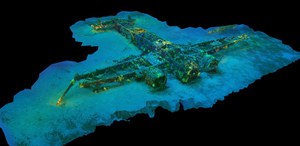Wrecks, waste and biodiversity in the depths of the Mediterranean
The seabed has always fascinated man and until a few decades ago what lay beyond 50 meters was shrouded in mystery. Thanks to a series of new underwater technologies developed in recent decades, such as 3D mapping, it is possible to obtain detailed images of submerged wrecks. Observing what is at great depths allows us to study biodiversity hotspots, facilitating actions to restore marine habitats.
- https://development.isprambiente.gov.it/en/news/wrecks-waste-and-biodiversity-in-the-depths-of-the-mediterranean
- Wrecks, waste and biodiversity in the depths of the Mediterranean
- 2024-04-16T00:00:00+02:00
- 2024-04-21T23:59:59+02:00
- The seabed has always fascinated man and until a few decades ago what lay beyond 50 meters was shrouded in mystery. Thanks to a series of new underwater technologies developed in recent decades, such as 3D mapping, it is possible to obtain detailed images of submerged wrecks. Observing what is at great depths allows us to study biodiversity hotspots, facilitating actions to restore marine habitats.
- When Apr 16, 2024 to Apr 21, 2024 (Europe/Berlin / UTC200)
- Where Rome, Auditorium Parco della Musica Ennio Morricone
-
Add event to calendar
iCal
With virtual reality viewers and 3D glasses, schools will be able to enjoy a fantastic immersive experience! The comic Twenty thousand networks under the sea, also in 3D, addresses the issue of marine litter, drawing attention to the impact that waste has on marine organisms and ecosystems and illustrating some positive actions achieved thanks to the collaboration between researchers and fishermen.
The initiative is organized by ISPRA as part of the Rome Science Festival

